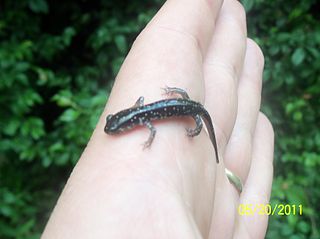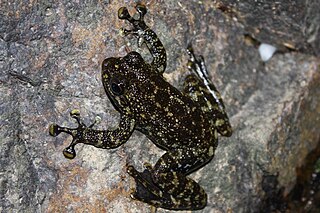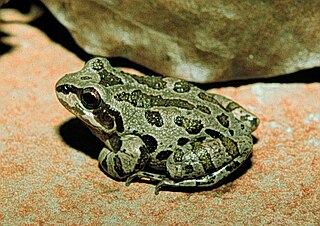 W
WThe Atlantic Coast slimy salamander is a species of salamander in the family Plethodontidae. It is endemic to the United States, where it is distributed throughout the Southeastern United States from southeastern Virginia to northern Georgia. It is largely distributed along the Atlantic coastal plain, although it enters the Piedmont in Virginia and South Carolina and enters the Blue Ridge Mountains in Georgia. Its habitat is largely restricted to bottomland hardwood forest. While its conservation status is considered Secure by NatureServe, declines have been noted in all studied populations.
 W
WThe Caddo Mountain salamander is a species of salamander in the family Plethodontidae endemic to Arkansas in the south-central United States, and only known from the Caddo Mountains, a part of the Ouachita Mountains.
 W
WThe Cumberland Plateau salamander is a species of salamander in the family Plethodontidae endemic to the United States. Its natural habitat is temperate forests. It is threatened by habitat loss.
 W
WHong Kong cascade frog or Hong Kong torrent frog is a species of true frog from southern coastal China, once thought to be endemic to Hong Kong. Their eggs are laid on rock faces in the splash zones of cascades. In Hong Kong, it is a protected species under Wild Animals Protection Ordinance Cap 170.
 W
WThe Illinois chorus frog is a species of chorus frog that lives in scattered, restricted habitat ecosystems in the states of Arkansas, Illinois, and Missouri. It was published by Smith in 1951. Its lifecycle is little known, its isolated populations are increasingly restricted by agricultural drainage, and it is listed as a threatened subspecies. It is often referred to as a subspecies of P. streckeri. Collins recognized it as its own species which was followed by ASW6.0 and Amphibiaweb on the basis of its diagnosability from Pseudacris streckeri and its allopatry. The IUCNredlist 2013.2 has not incorporated this taxonomic split.
 W
WThe southern torrent salamander is a member of the salamander family Rhyacotritonidae. This species of torrent salamander is found the farthest south in the region. It is a small salamander endemic to the Pacific Northwest from Northern California to Northern Oregon. It is one of four species of Rhyacotriton, along with R. cascadae, R. kezeri and R. olympicus. All species of Rhyacotriton are small, with their body lengths being less than 5 inches. The species reproduces annually, with an extended courtship and egg-laying period. The time it takes from oviposition to reach sexual maturity ranges from five to eight years, making the generation interval rather long. The larval stage, from hatching to metamorphosis, lasts 2.0-2.5 yr, with females requiring another 1.5–2.0 yr until they can first breed. They reach sexual maturity 1.0-1.5 yr after metamorphosis which occurs between 4.5 and 5.0 yr. This species feeds on small insects and spiders. Although it is found over a large area, it is not a migratory creature. It is preyed on by Pacific giant salamanders and garter snakes.
 W
WTelmatobius intermedius is a species of frog in the family Telmatobiidae. It is endemic to Peru. Its natural habitats are subtropical or tropical high-altitude shrubland, subtropical or tropical high-altitude grassland, and rivers.